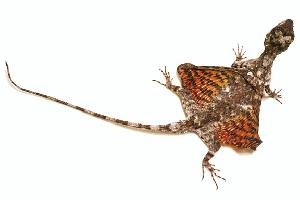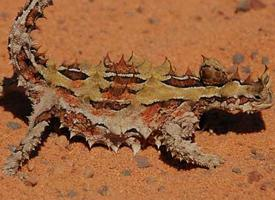
Váhy a míry
| Délka | od 20 do 25 cm |
|---|
Popis zvířete
The Common Flying Dragon (Draco volans) is a captivating species of lizard that belongs to the family Agamidae. This remarkable reptile is renowned for its extraordinary ability to glide through the air, a feature that not only distinguishes it from its terrestrial cousins but also adds a mythical aura to its existence. Native to the dense forests of Southeast Asia, including the Philippines, Malaysia, Indonesia, and Thailand, Draco volans has adapted remarkably well to its arboreal lifestyle, spending the majority of its life in the trees.One of the most striking features of the Common Flying Dragon is its "wings," which are not true wings but rather extended ribs covered with a thin membrane or patagium. This membrane is vividly colored, often displaying an array of bright hues such as orange, red, yellow, and blue, which contrast strikingly against the lizard's predominantly brown or gray body. The colors serve multiple purposes, including communication, mating displays, and predator deterrence. When the lizard leaps from a tree, it spreads these ribs and the attached membrane to create a wing-like structure, allowing it to glide gracefully through the air for distances up to 8 meters (26 feet), although some have been observed to glide for even longer distances under ideal conditions.
The Common Flying Dragon is a relatively small lizard, with an average length of about 20 to 23 centimeters (8 to 9 inches), including its tail, which is longer than its body and aids in steering during flight. Its head is adorned with a small, yet distinct, crest, and its body is covered in scales that provide camouflage among the leaves and branches of its forest habitat.
Primarily insectivorous, Draco volans feeds on ants, termites, and small beetles, which it hunts in the foliage. Its hunting strategy involves waiting patiently for prey to come within reach before striking swiftly. This dietary preference plays a crucial role in controlling insect populations in its ecosystem.
The mating behavior of the Common Flying Dragon is also noteworthy. Males are territorial and use their brightly colored patagia to attract females and intimidate rivals. They engage in aerial displays and physical confrontations to establish dominance and win the opportunity to mate. Females lay eggs in soft soil or leaf litter on the forest floor, where they remain until hatching. The young are born fully formed and are capable of climbing and gliding shortly after birth, ensuring their survival in the tree canopy.
Despite their fascinating abilities and ecological importance, Common Flying Dragons face threats from habitat destruction due to deforestation and land conversion for agriculture and human settlement. While they are not currently listed as endangered, their populations are vulnerable to the rapid changes occurring in their natural habitats.
In conclusion, the Common Flying Dragon (Draco volans) is a unique and enchanting reptile that embodies the intricate beauty and complexity of the natural world. Its ability to glide, vibrant colors, and intriguing behaviors make it a subject of fascination and highlight the importance of preserving its forest home for future generations to marvel at and study.
Podobná zvířata
Nové fotografie zvířat
Top 10 zvířat
- Dolphin gull (Leucophaeus scoresbii)
- Diana monkey (Cercopithecus diana)
- Moustached guenon (Cercopithecus cephus)
- Galápagos tortoise (Geochelone nigra complex)
- Stone loach (Barbatula barbatula)
- Japanese macaque (Macaca fuscata)
- Russian tortoise (Testudo horsfieldii)
- Greek tortoise (Testudo graeca)
- Common flying dragon (Draco volans)
- Vendace (Coregonus albula)


